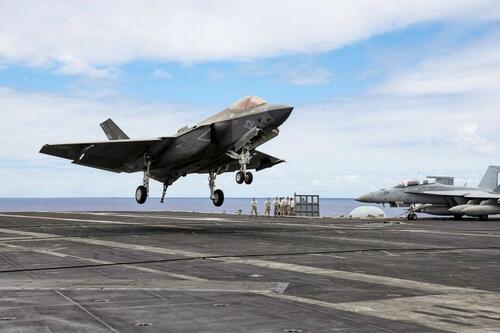
В докладе отмечается, что американские военные не имеют возможности победить Китай, что предполагает расходы на оборону в стиле холодной войны.
Автор Эндрю Торнбрук via «Времена Эпохи» (выделено нами)
В новом докладе Конгресса говорится, что вооруженные силы США не имеют необходимых возможностей для сохранения стратегических интересов страны и могут проиграть потенциальную войну против Китая.
 Самолет F-35 приземляется на взлетно-посадочной полосе авианосца USS Carl Vinson во время военных учений Rim of the Pacific (RIMPAC), примерно в 100 милях к югу от Оаху, Гавайи, 19 июля 2024 года. (Марко Гарсия/Файл Фото/Рейтер)
Самолет F-35 приземляется на взлетно-посадочной полосе авианосца USS Carl Vinson во время военных учений Rim of the Pacific (RIMPAC), примерно в 100 милях к югу от Оаху, Гавайи, 19 июля 2024 года. (Марко Гарсия/Файл Фото/Рейтер)В докладе, опубликованном 30 июля Комиссией по стратегии национальной обороны, говорится, что «военным США не хватает как возможностей, так и возможностей, необходимых для уверенности в том, что они могут сдерживать и преобладать в бою. "
«Комиссия считает, что американская оборонно-промышленная база не в состоянии удовлетворить потребности США в оборудовании, технологиях и боеприпасах, а также их союзников и партнеров», — говорится в докладе.
Эрик Эдельман, который является вице-председателем комиссии, заявил во вторник Комитету Сената по вооруженным силам, что коммунистический режим Китая опережает Соединенные Штаты в военном развитии.
По его словам, этот факт может увеличить вероятность конфликта между двумя державами и вероятность поражения США.
"Есть потенциал для краткосрочной войны и потенциал, что мы можем потерять такой конфликт.- сказал г-н Эдельман.
«Мы обнаружили, что Китай во многих отношениях опережает США», — сказал он. «Хотя у нас все еще есть самые сильные вооруженные силы в мире с самым дальним глобальным охватом, когда мы достигаем 1000 миль побережья Китая, мы начинаем терять наше военное господство и можем оказаться в проигрышном конце конфликта. "
С этой целью г-н Эдельман подчеркнул, что растущее стратегическое партнерство между Китаем, Ираном, Северной Кореей и Россией является «крупным стратегическим сдвигом», который не в полной мере учитывается планировщиками обороны США.
Он сказал, что, поскольку эти четыре авторитарных режима работают вместе против Соединенных Штатов беспрецедентным образом, Соединенные Штаты могут столкнуться с глобальным конфликтом, который истощит все их национальные ресурсы.
"Это делает каждую из этих стран потенциально более сильной в военном, экономическом и дипломатическом отношении и потенциально может ослабить инструменты, которыми мы располагаем для борьбы с ними.- сказал г-н Эдельман.
И это делает более вероятным, что будущий конфликт, например, в Индо-Тихоокеанском регионе, распространится на другие театры, и что мы окажемся в глобальной войне, которая будет масштабной Второй мировой войны.
Поэтому в докладе Комиссии содержится призыв к Конгрессу и различным правительственным ведомствам «переписать законы и правила, чтобы устранить ненужные барьеры для принятия инноваций, бюджетирования и закупок» в целях усиления сдерживания.
Кроме того, в докладе рекомендуется радикально трансформировать национальную стратегию, отойдя от «биполярной» стратегической модели холодной войны к «многотеатральной модели», которая учитывает тот факт, что Соединенные Штаты могут столкнуться с вооруженными конфликтами против нескольких национальных государств по всему миру одновременно.
Время не на стороне Соединенных Штатов, и Китай, вероятно, усилит свое враждебное поведение в ближайшие годы в попытке «нормализовать незаконное поведение». в том виде, в котором оно преследует цель "установления выгодных условий для будущего принуждения или конфликта. "
В докладе не делается двусмысленности по этому вопросу. Если не будут внесены изменения в национальную стратегическую позицию, вооруженное крыло коммунистического правления Китая, Народно-освободительная армия (НОАК), скорее всего, превзойдет силу американских военных.
"Если эти тенденции сохранятся, НОАК станет равным, если не превосходящим, военным конкурентом Соединенных Штатов во всех областях, ситуация, с которой Соединенные Штаты не сталкивались со времен разгара холодной войны.- говорится в докладе.
Председатель комиссии Джейн Харман заявила, что Соединенные Штаты должны синтезировать все инструменты своей власти, включая частные отрасли, для продвижения военных инноваций и внедрения новых технологий.
Для достижения этой цели в докладе содержится призыв к увеличению налогов, чтобы увеличить расходы на оборону США до уровней холодной войны, которые, по его мнению, упали между 4,9 и 16,9 процента ВВП.
Если предположить, что ВВП США в 2023 году составит около 27 триллионов долларов, это будет означать, что годовой оборонный бюджет составит не менее 1,3 триллиона долларов до 4,5 триллиона долларов, хотя в докладе говорится, что достижения в области коммерческих технологий уменьшат бремя расходов по сравнению с эпохой холодной войны.
"Мы обнаружили, что объединенные силы сегодня находятся на пределе готовности. Увеличение нагрузки без увеличения ресурсов для восстановления готовности приведет к ее разрушению.- сказала г-жа Харман.
«Мы рекомендуем коренные изменения в том, как Пентагон и другие правительственные учреждения ведут бизнес, как они используют технологии частного сектора и полностью поддерживают наших партнеров и союзников. Мы рекомендуем использовать все элементы национальной власти. "
Тайлер Дерден
Свадьба, 07/31/2024 - 20:50















